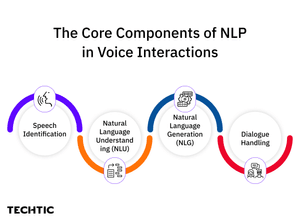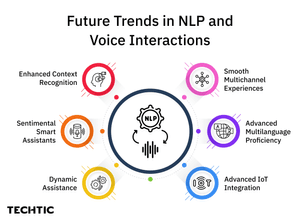How NLP is Revolutionizing Digital Assistants and Voice-Based Interactions
Sector: AI + Data
Author: Nisarg Mehta
Date Published: 12/16/2024

Contents
- Evolution of Digital Assistants: From Robotic Monotones to Conversational Champs
- Core Components of NLP in Voice-Based Interactions: The Brains Behind the Charm
- Applications of NLP in Modern Digital Assistants: From Basic to Brilliant
- Challenges in Implementing NLP for Voice-Based Interactions: Not All Smooth Talk
- Future Trends in NLP and Voice-Based Interactions: What’s Next for the Chatty Tech?
- Advanced Contextual Understanding: Bye-Bye, Repetition
- Emotionally Intelligent Assistants: AI with a Heart
- Proactive Assistance: Mind-Reading, Almost
- Seamless Multimodal Experiences: Talking and Typing Together
- Enhanced Multilingual Fluency: Babel, but Better
- Deep IoT Integration: How to Make the Smartest Home on the Block
- The Big Picture
- Conclusion: The future voice is here
Remember the days when yelling “Call Mom!” at your phone resulted in “Playing Love Bomb by AC/DC”? Yeah, we’ve come a long way. Enter Natural Language Processing (NLP)—the tech wizardry turning our awkward conversations with machines into smooth, almost-human dialogues.
NLP has taken digital assistants like Siri, Alexa, and Google Assistant from mere button-pushers to full-blown conversational partners. Now, you don’t just ask for the weather; you debate whether it’s sweater weather or hoodie season.
This article is your backstage pass on how NLP is revolutionizing digital assistants and voice-based interactions, peeling back the layers of tech magic to reveal the secret sauce behind your favorite virtual buddies.
Evolution of Digital Assistants: From Robotic Monotones to Conversational Champs
Once upon a time, digital assistants were like that one friend who only answered “yes” or “no.” Think of the early 2000s when voice systems could barely tell the difference between “send” and “end.” Their purpose? Perform basic tasks and frustrate users.
Fast forward to today, and digital assistants are the MVPs of modern tech. Thanks to NLP, they’re no longer just tools but companions—capable of cracking jokes, setting timers, and even delivering motivational pep talks. Siri’s sass? That’s NLP. Alexa recommends you add oat milk to your cart because you’re “out of stock”? NLP again.
From simple command-based systems to conversational multitaskers, the evolution boils down to one thing: understanding context. A decade ago, “Play Rock” might’ve fetched you a geology podcast. Now, you’ll get Led Zeppelin rocking your speakers.
Let’s not forget the real stars of this evolution:
- Siri (2011): The trailblazer that gave us our first glimpse of conversational AI.
- Alexa (2014): The queen of smart homes, connecting devices like a boss.
- Google Assistant (2016): The Einstein of digital assistants, flexing its superior contextual smarts.
It’s been a glow-up for the ages. But what powers this transformation? Time to dissect the tech that makes it all happen.
Core Components of NLP in Voice-Based Interactions: The Brains Behind the Charm
Ever wondered how your digital assistant deciphers “Can you set an alarm for my 6 AM meeting?” while you mumble it through a mouthful of toast? That’s NLP working its magic. Let’s break down its star players:

1. Speech Recognition: Turning Your Words into Code
Think of this as the ears of your digital assistant. With speech recognition, your spoken words are converted to text by speech recognition. It’s like having a super-efficient stenographer that doesn’t need to go to the coffee machine. The challenge? Battling accents, background noise, and your toddler screaming “Alexa!” every 10 seconds.
2. Natural Language Understanding (NLU): Reading Between the Lines
Once the words are decoded, NLU steps in like a language detective. It doesn’t just look at words; it deciphers what you meant. Say, “What’s the weather like?” and it understands you’re fishing for a temperature update, not a meteorology lecture.
3. Natural Language Generation (NLG): Crafting the Perfect Reply
Now comes the charm—NLG generates a response that feels less robot and more relatable. Whether it’s a weather report or a cheeky joke, NLG is behind that smooth-talking AI voice.
4. Dialogue Management: Keeping the Conversation Flowing
This is the glue that holds multi-turn conversations together. Ask your assistant to “Set an alarm for 7 AM” and follow it up with “Cancel it,” and it knows you’re still talking about that alarm. Dialogue management makes your assistant feel, dare we say, smart.
The Magic in Action:
Together, these components create a seamless experience. They listen to you and get you. That’s why we’ve stopped yelling at our devices and begun trusting them completely for predicting our music ordering our pizza, etc.
Applications of NLP in Modern Digital Assistants: From Basic to Brilliant
Digital assistants today are no longer just glorified alarm clocks or weather reporters. Thanks to NLP, they’ve become our personal concierges, therapists, and occasional DJs. Here’s how NLP supercharges their capabilities:
1. Personalization: Your Assistant, Your Way
NLP allows digital assistants to know you. It remembers your preferences, whether it’s your taste in music, your favorite coffee shop, or the fact that you prefer “sunny-side-up” mornings. Need proof? Ask Alexa for a breakfast recipe, and watch it suggest avocado toast because you googled it three times last week.
2. Multilingual Mastery: Parlez-vous Assistant?
Want to switch from English to Spanish mid-conversation? No problem. NLP empowers assistants to handle multiple languages seamlessly. They’re not just translating—they’re understanding cultural nuances and idiomatic expressions. No more awkward “machine speak” when you ask for directions in Paris.
3. Contextual Understanding: It’s Not Just Words
Gone are the days of repeating yourself like a broken record. Modern assistants pick up on context. Ask Google, “Who won the game last night?” and follow up with, “When do they play next?”—it knows you’re still talking about your favorite team. Contextual smarts are what make NLP-powered assistants feel…human.
4. Sentiment Analysis: Feeling You, Literally
Digital assistants don’t just hear you; they sense you. Sentiment analysis enables them to detect emotions. Sound frustrated while asking for tech support? Your assistant might calm you with a polite tone or extra empathy in its response.
Real-World Examples
- Spotify Recommendations: Siri knows your post-workout vibe is all about chill beats and queues them up without you lifting a finger.
- Smart Home Integration: Alexa dims the lights and sets the thermostat because you said, “Goodnight.”
- Customer Service Bots: NLP-driven assistants resolve queries faster than you can say, “representative.”
These applications aren’t just convenient. They are redefining the idea of being ‘intelligent’. Of course, with the great, there’s the challenge. Let’s talk about those next.
Challenges in Implementing NLP for Voice-Based Interactions: Not All Smooth Talk
Creating NLP for voice-based systems is not as trivial as it sounds. The picture of seamless interaction is always a matter of being up against so many obstacles. Here’s a peek at the tough nuts to crack:
1. Privacy Concerns: Is Big Brother Listening?
Imagine telling Alexa your weekend plans and then wondering if the assistant is a little more like James Bond than you thought. Sensitive data is stored, analyzed, and even leaked, and users worry about it. Today’s data-conscious world, means developers have their work cut out for them in juggling providing value while respecting privacy.
2. Security Risks: Voice Impersonation is the Problem
Spoofing attacks can happen on voice-based systems. And if a server lets someone mimic your voice, they could use that to get at sensitive information. To fix that, you need advanced voice authentication, but the tech race has been far from over.
3. Bias in NLP Models: Who’s Being Left Out?
NLP systems often mirror the biases in the data they’re trained on. Mispronunciations, accents, or even certain languages may result in inaccuracies. Ever tried getting a voice assistant to recognize regional slang? It’s a humbling experience. Fixing bias requires diverse datasets and ongoing fine-tuning.
4. Contextual Failures: When Assistants Drop the Ball
Not every interaction is smooth sailing. Complex queries or vague follow-ups can confuse assistants. Ask, “Can you turn off the fan and then dim the lights after five minutes?” and you might hear a polite, “Sorry, I don’t understand.” Teaching systems to handle layered instructions is a major challenge.
5. Technical Limitations: Can You Hear Me Now?
Background noise, speech variations, and mumbling wreak havoc on speech recognition. Even the most advanced NLP systems have moments where they say, “Did you mean…” and completely miss the point.
The Balancing Act
Overcoming these challenges requires a blend of cutting-edge technology and ethical considerations. The goal? To create digital assistants that are not only smart but also secure, unbiased, and dependable.
Having an NLP and AI development partner like Techtic Solutions by your side can ease the pain of these challenges. Companies like us have been building NLP solutions for a very long time and can help you build yours too.
Future Trends in NLP and Voice-Based Interactions: What’s Next for the Chatty Tech?
Digital assistants are not on a journey to just set alarms and play songs. In an ever-accelerating online world, now is the time to be prepared when it comes to NLP and the future that awaits. Here’s what’s on the horizon:

1. Advanced Contextual Understanding: Bye-Bye, Repetition
The future of NLP lies in mastering context at a deeper level. Imagine your assistant remembering conversations across days or even weeks. Ask, “What’s the best time to visit Bali?” and months later, follow up with, “Book that trip now,” and it knows exactly what you mean—no re-explanations needed.
2. Emotionally Intelligent Assistants: AI with a Heart
Soon, your assistant won’t just hear you—it’ll feel you. NLP systems will become emotionally intelligent, detecting moods and tailoring responses accordingly. Feeling stressed? Your assistant might suggest a meditation session or crack a joke to lighten the mood.
3. Proactive Assistance: Mind-Reading, Almost
Your future assistant will know your needs before you express them. While you’re sitting, expect things like, “You’ve been sitting for an hour—want to stretch?” or “Traffic’s heavy, should I reorder your coffee for later?” They’re like your personal life coach, they’ll never miss a beat.
4. Seamless Multimodal Experiences: Talking and Typing Together
Tomorrow’s assistants will be able to accomplish the same tasks using voice, text, and visual interfaces. Imagine performing a voice search for “best pasta recipes,” and a step-by-step appeared on your smart display without you lifting a finger.
5. Enhanced Multilingual Fluency: Babel, but Better
Assistants will soon handle not just multiple languages but also dialects, slang, and cultural nuances. Fluent in Spanglish? Your assistant will be, too.
6. Deep IoT Integration: How to Make the Smartest Home on the Block
As the Internet of Things grows, so will NLP-powered assistants that will effortlessly link all of your home devices. You can say, Movie night, and your assistant lowers the lights, and the thermostat, and preps the popcorn popcorn maker.
The Big Picture:
NLP’s role in voice-based interactions is only going to grow from there, from enhancing accessibility to offering hyper-personalized experiences. You can think of it as your future tech sidekick that’s on the way to becoming a full-fledged superhero.
Conclusion: The future voice is here.
NLP has transformed digital assistants and voice interactions, from fumbling with command systems that are only marginally more human than a digital recorder to chatting with assistants that feel close to a friend. Getting the job done is no longer enough, it’s about delivering seamless, intuitive, or even delightful experiences.
While NLP continues to progress, so will our assistants – becoming smarter, more empathetic, and proactive. We’ll know them better than some of our closest friends (a little creepy, but mostly exciting). From simplifying our daily mundanities to keeping us entertained, to being there to answer life’s odd questions, digital assistants will be around whether we like it or not—and will only continue to improve.
So, the next time Alexa cracks a joke or Google Assistant nails a complex query, give a little nod to NLP. It’s the silent genius working tirelessly to make our lives easier—and maybe even a little magical.



